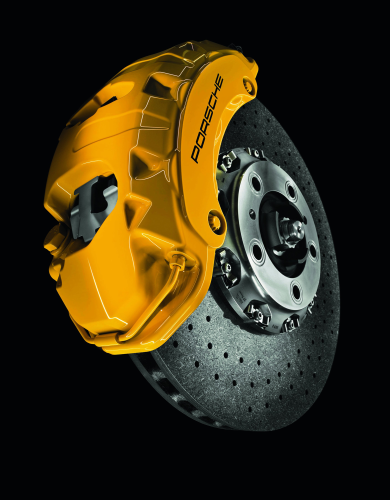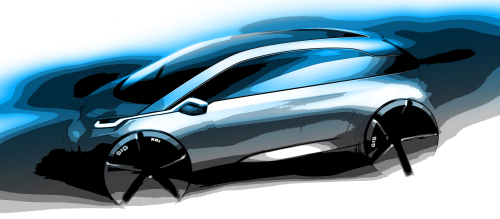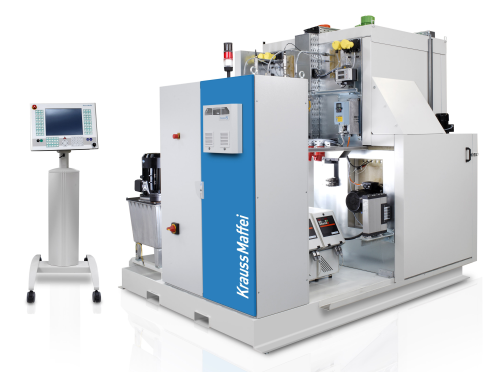




The ability to mass produce high-quality vehicle components from composites is influenced by two criteria – cycle times and the quantities required for economic production. The automotive industry is working on automated mass production techniques for carbon composite components to address these issues.
At COMPOSITES EUROPE 2011, numerous companies will demonstrate their technology for the manufacture of carbon fibre reinforced plastics (CFRP) components for the automotive industry.
High pressure RTM
Lightweight automotive construction with FRP is a major focus for the Reaction Processing Division of the KraussMaffei Group. The company has developed a modular equipment concept that covers the production of a CFRP component using the high pressure resin transfer moulding (HP-RTM) process.
Production of the parts commences with incorporating the dry fibre preforms into a mould specially designed and made by KraussMaffei.
“The use of parts based on injection moulding engineering in the design of the MX600 mould carrier particularly appeals to us,” says Frank Peters, managing director of KraussMaffei Technologies GmbH. “It is a modular approach in which, by using proven parts, we exploit the advantages of series injection moulding to arrive at application-specific solutions.”
A RimStar thermal mixing and metering unit features a new stainless steel pump for supplying material to the RTM high-pressure mixing head. The head mixes the components under high pressure, adds internal release agent and delivers the matrix material into the mould.
Inside the closed mould, the carbon fibres are impregnated with resin, and then cured in a cycle time of less than 4 minutes.
The parts are then removed and passed to a RoutingStar milling cell where they are machined. CFRP cutting tools and an improved, patented extraction system within the cutter head eliminates dust and reduces part contamination.
Polyurethane machinery specialist Hennecke is also participating in COMPOSITES EUROPE 2011. The company will be showcasing its equipment for the manufacture of fibre-reinforced structural components by the HP-RTM process. As Hennecke explains, in contrast to the traditional RTM process, the HP-RTM technique enables the reactive mix to be quickly injected into the cavity, meaning that curing times are extremely short and guaranteeing optimised cycle times for the whole process.
BMW
BMW is working on its first mass-produced electric vehicle. The BMW i3 (formerly known as the Megacity Vehicle) is scheduled to come of the production line from 2013 and features the extensive use of CFRP.
BMW engineers have redesigned the vehicle's architecture to produce the LifeDrive concept. The Drive 'module' – an aluminium chassis – forms the foundation of the vehicle and integrates the battery, drive system, crash elements and suspension into a single construction. The Life module consists primarily of a high strength, lightweight passenger cell made from CFRP.
In the past ten years, the BMW Group has gained considerable competence in CFRP production processes and it has developed and automated the production process in its Landshut works, so that the economic and high-quality mass production of CFRP components is now possible.
The carbon fibres BMW is using are being produced in a joint venture with the SGL Group, which is also exhibiting at COMPOSITES EUROPE.
Mercedes, Audi and Lamborghini
Other car manufacturers are also increasing their use of carbon fibre.
After trials in the SLR super sports car, Daimler is planning to incorporate more CFRP in its standard Mercedes-Benz models from 2012. The company has entered into a partnership with Japanese carbon fibre manufacturer Toray and it plans to employ CFRP in production vehicles with volumes of some 20 000-40 000 units. The CFRP components will be produced using an RTM process developed by Toray.
Audi has set up an interdisciplinary technical centre for CFRP at its Neckarsulm site in Germany. The objective is to industrialise the CFRP process technology for use in mass production. The company intends to employ composites in an "intelligent material mix" with, for example, aluminium and steel, in such a way that will lead to the best solution. The prepreg process employed for the Audi R8 GT involves a production time of around 4 hours and is suitable for small series production. The RTM process has a higher potential for automation and is employed in the Audi R8 Spyder; the cycle time is only 30 minutes.
Lamborghini set up its Advanced Composites Research Center (ACRC) in Sant’Agata Bolognese, Italy, in 2010. During the setting-up phase, a new, more efficient production process for highly complex CFRP structures was developed. Lamborghini engineers are focusing on out of autoclave technologies such as RTM and compression moulding.
Potential
The initiatives of the automotive industry demonstrate the potential that the vehicle market presents for processors of carbon composites and manufacturers of suitable processing technology. Only one fact could restrict the progess of CFRP. Since carbon fibre is also being increasingly used in the aviation, sport and other industries, some experts are already predicting that there may not be enough material for high-volume car models. ♦
COMPOSITES EUROPE is organised by Reed Exhibitions in cooperation with the European Composites Industry Association (EuCIA) and Reinforced Plastics magazine. Over 300 exhibitors are expected at COMPOSITES EUROPE 2011 in Stuttgart, Germany, on 27-29 September. A prelude to the trade show is the annual conference of the German Federation of Reinforced Plastics (AVK) on 26-27 September.





